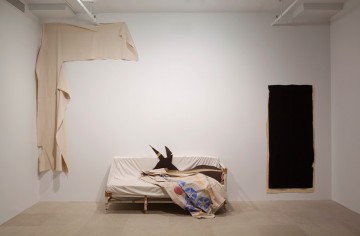
Gedi Sibony, "The Cutters, From The Center, Her Trumpeted Spoke Lastly," 2007 /2010. Canvas, paint, wall, hollow-core door, matted drawing reversed in frame, 137 x 164 x 13 inches / 348 x 416.6 x 33 cm. Courtesy Greene Naftali Gallery, New York. Photo Credit: John Berens
The invitation for Gedi Sibony’s solo show at Greene Naftali consists of a large grid of uneven lines with the exhibition details run along the edges. The work in the show itself proves to be equally asymmetrical and minimal with unpolished materials creating incomplete scenes around the gallery space. A large unfinished wall partition, The Cutters, greets visitors in the main space. Parts of the wall are missing and the inner framework is exposed on the sides. The white paint job is also only half done and two pieces of canvas hang around a doorway that leads to an industrial-looking door firmly attached to the back wall. An open, jerry-built wall leading to a firmly closed one.

Gedi Sibony, "The Brighter Grows the Lantern," 2010. Vinyl, nails, and light, dimensions variable. Courtesy Greene Naftali Gallery, New York. Photo Credit: John Berens.
In the following room, The Brighter Grows the Lantern consists of a large sheet of vinyl that blocks a direct view of the illuminated wall as you enter (echoing Olafur Eliasson’s recent installation at Tanya Bonakdar). The vinyl also reflects the warm shower of light back into the space and the atmospheric radiance is almost perfect until you turn to leave and find the wall by the door has been stripped away, overshadowing the corner with a darker tenor. Next door, Who Attracts All That Is Named seems like the makings of a shambolic living room stage set formed of objects plucked from the street, while the raised platform sculpture, Sets Into Motion, in the back space is equally ramshackle and resembles a flimsy, Richard-Tuttle-like loft bed, with the title also adding a domino-fall precariousness to it.
Instead of creating slick installations, Sibony uses basic materials — drywall, wood, screws, paint, canvas, etc. – that are openly revealed, thereby becoming autonomous and elevated in their import much like Rauschenberg’s works. He also sets up a dialogue between painting and sculpture, with echoes of Robert Ryman’s abstract works running throughout. However, rather than offering abstracted, fragmentary objects that intervene within the space as in his past exhibitions, Sibony appears to be aiming for more of a theatrical cohesiveness here, where grasping at a sense of unity becomes easier through staged encounters.

Gedi Sibony (with Diana Lyon), "Who Attracts All That is Named, It Speaks of Them as The Three Bodies," 2010. Canvas, sofa, foam, tape, and cloth, vinyl, dimensions variable. Courtesy Greene Naftali Gallery, New York. Photo Credit: John Berens.
This collection of objects and half-built constructions strips bare the architectural space and reveals a rawness beneath. There is something uncomfortable about the incompleteness that interrupts each room, as though Sibony has thrown together shoddy stage-props to represent someone’s (our?) unrefined existence. Knowing that we are unable to improve these structures leads to a frustrating situation, one that we try and avoid or turn away from. However, our relationship with them is more complicated than simple aversion since there is a primal purity and vulnerability to these pared-down arrangements that draws us back towards them. Sibony has created a place back in the constructed world for these found (once discarded) objects, a place that dramatically increases their former value and realigns their use into antagonistic, aesthetic objects.



